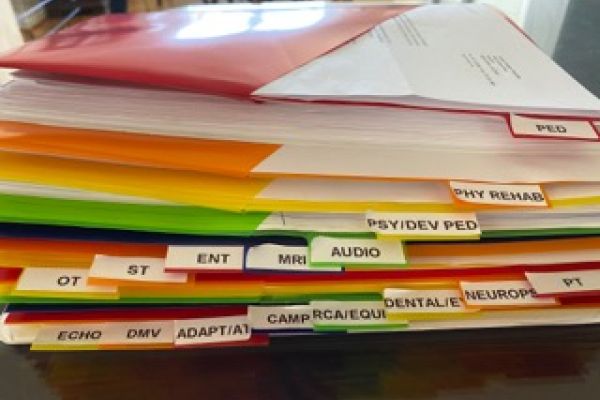
A Parent’s Ultimate IEP Meeting Checklist
| Development Of The IEP, Early Intervention, Educational Evaluations, Eligibility, Eligibility Meetings, Evaluation, Featured Article, Identification, IEP, IEP Meetings
Empower Your Child’s Success
Navigating the world of education for a military child with special needs can be both challenging and rewarding. In our previous newsletter, we shared a letter template for requesting an Individualized Education Program (IEP) meeting.
Preparing for an IEP meeting is as crucial as the meeting itself. You play a pivotal role in shaping your child’s educational experience. To ensure you make the most of this opportunity, we prepared a checklist to guide you through a comprehensive IEP meeting. Let’s embark on this empowering journey together!
Understanding the IEP Meeting
Before you even step into the meeting room, it’s essential to grasp the purpose and significance of an IEP meeting. Knowing that it’s a collaborative effort between you, the educators, and related service providers to tailor your child’s education to their unique needs will set the tone for a successful meeting.
You can choose to invite a friend, advocate, attorney, or subject matter expert to be present. Inquire with your local Exceptional Family Member Program (EFMP) branch if there are case managers or liaisons available to attend the IEP meetings with you.
Collecting Relevant Documents
Prepare a folder or binder with all the necessary documents, including your child’s current IEP (if one is already in place), progress reports, medical records, and any correspondence related to their special needs. Partners in PROMISE (PiP) created a comprehensive Special Education and EFMP binder that can help fully prepare and organize your documents so that you can refer to these documents when needed during the meeting.
Define Your Goals and Concerns
Take some time to reflect on your child’s progress, strengths, and areas where they may need more support. Jot down educational goals and concerns in a Parent Input Form, making them as specific as possible and submit the form to the IEP Team prior to the meeting. A customizable Parent Input Form can be found in PiPs Special Education and EFMP binder.
Most importantly, take time to listen to your child’s concerns about school. This may seem like an arduous process, and we understand! From experience, we believe bringing this information to the IEP meeting will help you clearly articulate your goal and concerns.
Prepare Questions
Formulate a list of questions to ask during the meeting. These can range from clarifications about your child’s progress to understanding the goals set in the new IEP. Well-thought-out questions show your commitment to your child’s education.
Know Your Rights
Familiarize yourself with your rights as a parent of a child with special needs. Understanding the laws and regulations that govern IEPs, such as the Individuals with Disabilities Education Act (IDEA), empowers you to advocate effectively.
Furthermore, Partners in PROMISE created its own Special Education “Bill of Rights” for military families. It includes reminders of your rights for IEP meetings, consent requirements, dispute and resolution procedures, and Free Appropriate Public Education (FAPE).
Stay Positive and Open-Minded
Approach the meeting with a positive attitude and an open mind. Remember that everyone at the table shares the common goal of providing an appropriate education for your child. Being receptive to suggestions and willing to collaborate is key.
Take Notes
During the meeting, take detailed notes to ensure you capture all important information, decisions, and action items. These notes will serve as a valuable reference point for future discussions. Also, you can choose to audio record your meeting. Please check with your State regulations first on how to provide notice if you decide to record.
Follow-Up
After the meeting, follow up with the school to ensure that the agreed-upon actions are being implemented. Expect to receive the required Prior Written Notice (PWN). This notice tells the parent what actions were accepted and refused during the IEP Meeting. PWNs should be given before any action is taken. Stay involved in your child’s education, measure progress at home, and don’t hesitate to schedule additional meetings.
Conclusion
As a parent, your involvement in your child’s IEP meeting is a vital step toward ensuring they receive the best possible education and support. By following this checklist, you can confidently navigate the process, advocate for your child’s needs, and help them achieve their full potential. Embrace the journey, for it is a journey of empowerment and hope for your child’s future.
About the Author
Carly Brinsko, Content Manager

Carly Brinsko, Content Manager with Partners in PROMISE, has been part of the military community for over 16 years. She is a devoted mother to two children, Colton and Wyatt. Currently residing near Fort Liberty, North Carolina, Carly’s fondest duty station memory is from Fort Knox, Kentucky, where she cherished the small-town atmosphere and warm southern hospitality.
Carly holds a Bachelor’s Degree in Early Childhood Education, which she earned in 2006. From 2007-2009, she dedicated herself to pursuing a Master’s Degree in School Counseling and graduated with honors, showcasing her steadfast commitment to personal growth.
As a former educator, school counselor and mom of children with special needs, Carly possesses firsthand experience in addressing the challenges of navigating special education. Throughout the COVID-19 pandemic and a subsequent PCS move, Carly took on the role of homeschooling her children. Currently, she works in Quality Assurance & Compliance with an educational software company.





Leave a Reply